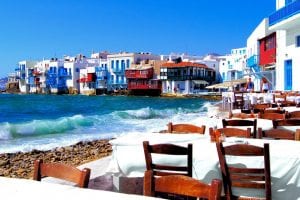By Bruno Husquinet, Modern Diplomacy
Churches think in centuries and are not bound to short-term political mandates. On January 5, 2018 the Patriarch of Constantinople implemented his decision to grant independence to the Ukrainian Orthodox Church, a move that upset Moscow. To understand the current developments, it is worth looking back at this centuries-long history of fluid relationship between Constantinople, Kiev and Moscow.
Constantinople-Kiev: Christianization
In 882, Oleg of Novgorod moved his capital to Kiev and continued the work of Rurik to unite Slavic tribes, setting the stage for the history of Kievan Rus. The prediction of Saint Andrew was unfolding. It is said that during the first century, when Andrew the Apostle traveled to what is now Kyiv, he climbed onto a hilltop overseeing the Dnepr River. There he planted a cross, prophesizing the future of the great Christian city and the role it would play.
The Slavs were a loose union of tribes, whilst Constantinople was flourishing. In 980, Vladimir the Great ruled in Kiev and endeavored to consolidate and expand further his territories. In 988, he conquered the city of Kherson, in Crimea, where a bishop see had been established since the fourth century. Although accounts vary on the conversion of Vladimir, what is clear is that the Byzantine emperor sent his sister Anna to marry Vladimir, uniting Kiev and Constantinople. When Anna arrived, Vladimir converted to Christianity, restored Kherson to Constantinople, and returned to Kiev with Crimean ecclesiastics. It is undeniable that economic and political reasons influenced his choice to convert as his agenda leaned toward the Christian world.
Although the Byzantine emperor appointed the head of the clergy in Kiev, he faced opposition from the Kievan princes who did not endorse a filiation of churches from Constantinople, nor did they submit to the emperor’s authority to make Kievan Rus a colony of the Byzantine Empire. Relations with the empire were complicated: Constantinople did not mingle directly in Kiev’s internal affairs but would not let the princes interfere in religious matters. In other words, the authority of Constantinople over Kiev was exerted through the clergy, who enjoyed considerable powers in Kievan Rus. As a consequence, the first inclination toward creating an independent church appeared. Yaroslav the Wise proclaimed Hilarion of Kiev the first non-Greek metropolitan in 1049. Nonetheless, Constantinople regained control over the appointment of the head of the church in Kiev. Constantinople never bestowed upon Kiev the right to appoint its own Slavic metropolitan, establishing a red line that would trigger immediate action from Constantinople. For centuries to come, the position would mostly be held by Greeks, who remained outside of internal Kievan politics. As Kiev had grown to be a major economic center, it was in Constantinople’s interest to stay on good terms with its Slavic neighbor, gaining importance on the international scene.
Yaroslav the Wise passed away in 1054, a key date as it is the year of the schism between Rome and Constantinople.
Kiev choses Constantinople over Rome
Opinions on rites and theological elements diverged over time between Rome and Constantinople, in part because of linguistic differences. Latin became dominant in the West while Greek was the language of choice in the East. Because of the status of language as a major cultural vehicle, the use of different languages impacted religious rites. Gradually, Rome imposed the closure of churches following the rites as practiced in Constantinople and Constantinople did the same to churches following the practices of the Western Church. Eventually, the Roman pope Leo IX and Michael Cerularius of Constantinople excommunicated each other in 1054.
Humbert of Silva Candida, the papal legate who delivered the excommunication to Patriarch Michael Cerularius, decided to stop by in Kiev on his way back to Rome from Constantinople. The newly converted Kievan Rus represented an attractive potential ally for Rome, especially given that the young federation of Slavs was expanding in size and importance on the international scene. Since integrating with this new community of Christians would strengthen their hand against Byzantium, Rome’s envoy visited the Grand Prince of Kiev with the aim of convincing him to join Rome. Yet Yazislav, the new Grand Prince of Kiev, refused any allegiance to Rome. The clergy in Kiev would remain on the Orthodox side with Constantinople in the great East-West schism.
But rivalries amongst Slavs were fierce. In 1169, the pious Grand Prince of Vladimir-Suzdal Andrey Bogolyubsky sacked Kiev and took many religious pieces, including a highly revered Byzantine icon of the Mother of God of Odigitriya, one of the holiest in Russian Orthodoxy. He initiated the construction of many churches in Vladimir-Suzdal, near today’s Moscow and converted more Slavic tribes. He is also renowned for having made the first attempt to set up a new eparchy to compete with Kiev. Around the year 1170, he bypassed the Kiev Patriarchate and directly requested of the Patriarch of Constantinople, Luka Khrizovergus, that he established an eparchy in Vladimir. He also asked for the new metropolitan to have the same rank as the one in Kiev. The patriarch declined his request, but the competition with Kiev had begun.
Moscow enters the scene
The Mongol invasion spread quickly from east to west and reached Kiev in 1240. The city was destroyed and almost its entire population was dispersed. Kiev, the beautiful jewel of a city was shattered. Some sixty years after the destruction of Kiev, the city was still not recovering. So, the metropolitan Maksim moved his residence from Kiev further east to Vladimirin 1299. Nonetheless, he kept his title of Metropolitan of Kiev and All Rus. The transfer of the religious center from Kiev was a major move, the consequences of which greatly affected the future of Orthodoxy and lay power as well. At that time, the Mongol dominated the region. The first union of Slavs, the Kievan Rus had disappeared and new states had not formed yet.
In a short span of three decades, major events shaped the face of the new power that emerged in Moscow, the capital of the Grand Duchy of Moscovy.
Under the relative religious tolerance of the Mongols, the church consolidated its power and the metropolitan Piotr moved to Moscow in 1325, giving the sign that the city was one of the leading politico-religious centers.
In the meantime, Constantinople was mired in its own problems and the Eastern Roman Empire was suffering through its last days. As the Vatican was entering the Renaissance era, it was eager to end the 1054 schism, especially to its own advantage. Thus the Catholic pope was well inclined to help Constantinople, which had asked for help and unity in resisting the Ottoman threat. At the Council of Florence in 1439, the Catholic Church and the Patriarch of Constantinople signed an agreement that should have put an end to the schism. At that time, Constantinople was still appointing the Metropolitan of Kiev and All Rus, and it counted on the support of Moscow to endorse the agreement. But reality dictated otherwise as Russia had gained much distance from Constantinople and its issues. The Patriarch of Constantinople died soon afterward, and it was decided that his signature was nonbinding for the Orthodox churches. Only Constantinople still hoped that the union with Rome would save them from the Ottomans. But a decade later, in 1453, Constantinople fell under the control of the Ottomans.
Moscow-based bishops decided to emancipate themselves from Constantinople, which had compromised with the Catholics to save itself, yet was now under Muslim rule. For the first time, Moscow elected its own head of the church, independently from Constantinople. Although the autocephaly of the Russian Orthodox Church was recognized only in 1589, the church became de facto independent in 1448, with Jonah as its first metropolitan. One of his first objectives was to maintain religious unity in territories over which his predecessors had authority. Eventually, in 1458, the canonical territories over which the metropolitan professed corresponded to those over which the Grand Prince of Moscow ruled. This transition was reflected in his title, which changed in 1461 to Metropolitan of Moscow and All Rus. The Russian Church was now an actor of importance that saw itself as the guardian of Orthodoxy, the Third Rome.
The new Autocephalous Church asserts itself
The remaining element was the recognition of autocephaly by Constantinople. Without the approval of its peers, the self-proclaimed autocephaly has no validity in the Orthodox world.
The Ottomans imposed heavy tributes on patriarchates that fell under their territorial control. Economically weakened, the patriarchates lost considerable weight, especially Antioch, which had been weakened and forced into exile several times due to centuries under the dominion of Arabs and crusaders. In 1586–1587, the patriarch of Antioch, Joachim V, engaged in a journey to collect donations from other Orthodox churches. In Moscow, the future tsar Boris Godunov offered his support and seized this political moment to stir ambitions of an official autocephaly. Two years later, the patriarch of Constantinople, Jeremias II, traveled to Moscow with the same objective of collecting money. During his stay, he would have discussed with Boris Godunov the possibility of remaining the Orthodox Ecumenical Patriarch but being based in Russia. Finally, after lengthy negotiations, Jeremias II decided to give autocephaly to the Russian Orthodox Church and returned home. The recognition was made official in 1589 with the concurrence of the other three original patriarchates of Alexandria, Antioch, and Jerusalem.
In 1589, the Russian Orthodox Church for the first time had a patriarch at its head, Job of Moscow. There were now five patriarchs: Constantinople, Alexandria, Antioch, Jerusalem, and Moscow. And the tsar was the guardian of Orthodoxy.
Kiev, the Tsarist Empire and the church
Peter the Great launched many reforms to modernize Russia, following European model. He replaced the patriarchate with a committee termed the Holy Synod, placing a bureaucrat, the Chief Procurator, as its de facto head and the tsar’s eyes and ears in the church. With authority over religious matters and control over the appointment of bishops, Peter succeeded in relegating the church to the status of a ministry or state department, with clerics placed in charge of spiritual matters.
Catherine the Great continued the policies of Peter the Great. She entertained the Austro-Russian idea of dissolving the Ottoman Empire. As part of this scheme, she nurtured plans to embark on a “Greek Project”: re-establishing a Greek Byzantine empire to replace the Muslim Ottoman Empire, which had gained ground in continental Europe. For instance, she supported the Daskalogiannis Rebellion in Crete in 1770, in which Cretans rose up against the Turks. In reality, she was rather indifferent to religion: she embraced the project, promoted by Prince Potemkin, for geopolitical rather than religious reasons. Yet it did not materialize, and no alliance with Austria came into being. In 1783, Catherine decided to annex Crimea, putting an end to the revolts occurring there and, most importantly, pushing the Ottoman Empire back across the Black Sea. Crimea became a Russian province and part of Novorossiya or “New Russia” in 1784.
Religion politics in Russo-Turkish Wars
Eventually, tensions between the Russian and Ottoman empires had reached a climax, and war broke out in 1787. The conflict lasted for five years but was decided to Russia’s advantage. Russia was therefore able to consolidate its positions around the Black Sea but never captured Constantinople, the gateway to the Mediterranean’s warm waters and an Achilles heel for Moscow to this day. Even though the Treaty of Jassy, signed at the end of the war on January 9, 1792, recognized the Russian territorial gains, relations with the Ottoman Empire remained tense. Russian expansion benefited from momentum on the world scene shaken by the French and American revolutions. Consequently, nobody really reacted to Russian expansion until the situation in France had stabilized. But Napoleon reaction was short-lived.
Alexander’s victory over Napoleon gave him a new sense of divine mission, and by 1814, the tsar had grown more religious and prone to messianism. His religious awakening triggered his initiation of the Holy Alliance between Prussia, Austria, and Russia. Signed in Paris in 1815, this alliance aimed to promote Christianity but was also a reaction to the Napoleonic Wars. The Great Powers wanted to ensure a balance of power in Europe and avoid revolutions. During the two hectic decades that followed, the Catholic Church remained strong and Napoleon III pursued a pro-Catholic agenda, as proven by his 1849 expedition to restore the pope. He posed as the champion of Catholicism in Europe, which in part explained his decision to engage in the Crimean War against Russia.
With its territorial gains and advances well into the Black Sea region, Russia represented a growing threat for the Ottoman Empire and its French and British allies. Paris, together with London, backed the Ottoman Empire, whose western territories in the Balkans saw many uprisings, such as those of the Orthodox Serbs and Orthodox Greeks.
The trigger of the Crimean War of 1853–1856 was religious, but the roots were indisputably linked to the fear of Russia’s growing influence in the weakened Ottoman Empire. At the beginning, quarrels between Catholic and Orthodox monks arose in Palestine about their prerogatives. As the matter had reached serious levels, Tsar Nicholas I intervened and asked the Sultan to recognize the right of Russia to protect the Christians of the Ottoman Empire according to the Treaty of Küçük Kaynarca, signed after the war of 1774. This right gave the Russian Orthodox Church further predominance over the Patriarchate of Constantinople. The document also gave Russia access through the Bosphorus and the Dardanelles. This privilege was certainly not pleasing to France or England.
Catholic France declared that it wanted to have authority over the Eastern Christians, a decision contradicting a previous agreement that gave Russia the right to protect Christians. The French Catholic Emperor Napoleon III promised support to the Sultan if he were to resist this Russian “aggression.” Stung by the humiliating conditions of the treaty following the Ottoman defeat, the Sultan agreed. Consequently, a new war erupted between the Ottoman Empire and Russia. As promised, France, joined by England, intervened in support of the Sultan to preserve the territorial integrity of his empire.
The protection of holy places and Christians became the source of an international war with several fronts around the Black Sea, including in the Caucasus. The war was eventually lost by Russia, which was then forced to hand over several territories around the Black Sea. As a result, France gained influence in the Holy Lands.
Moscow – Constantinople Competition
World War 1 put an end to both Russian and Ottoman empires. Under the Soviet, religion was undermined, priests were killed and churches destroyed. So, the Russian church found itself in a state of confusion when the Soviet government collapsed. The church was divided and weak. During the final years of the twentieth century, the ROC stabilized and consolidated its power over its canonical territory thanks to the support of the Russian authorities. It also reasserted its stance within the Orthodox Church worldwide. By far the largest in terms of parishioners and with growing wealth, the Russian Orthodox Church overshadowed the patriarch of Constantinople.
The later did not enjoy much freedom under the new Turkish rule. In addition, it had lost jurisdiction in the Balkans in the nineteenth century. Turkish authorities imposed that the Patriarch should be a Turkish citizen, usually of Greek origin, and such candidates are rare. All in all, the Patriarch of Constantinople has been in an increasing difficult position for centuries, and Moscow has proved to be a strong challenger. In 2016, the ROC asked to convene the Pan-Orthodox Council in Crete and not in Istanbul as Turkish authorities had downed a Russian jetfighter deployed for operations in Syria. Based on this security argument, the Council agreed to change location. Nonetheless, local Orthodox churches, namely the Bulgarian Church, the Greek Orthodox Patriarchate of Antioch, and the Serbian and Georgian Orthodox churches refused to participate because of disagreements over the agenda. The ROC suggested solving those issues to guarantee full attendance, even if it meant postponing the Council. Eventually, the disputes were not resolved and the ROC decided to cancel its participation. By so doing, the ROC expressed a defiant message about the role and authority of the Constantinople Patriarchate. Tensions never resolved and the situation in Ukraine added insult to injury in the relation between Constantinople and Moscow.
Moscow – Kiev: rivals once more
Since the mid seventeenth century, Kiev remained largely under the rule of the Tsar and then Soviet Moscow. Ties binding Ukraine and Russia were strong especially in the field of alimentation, industry and energy.
After the end of the Soviet Union, the Western European World and Russia have tried to attract Kyiv into their respective spheres of influence, a game from which Kiyv benefitted. In 2014, the tables turned drastically with the Euromaidan revolution that toppled President Yanukovych. Incapable of averting Ukraine’s choice of the EU, Moscow was concerned that Ukraine might ally with NATO. Russian authorities treated the situation as a security matter and actively supported the separation of the autonomous region of Crimea and its attachment/annexation to Russia. The situation spiraled out of control and a kinetic conflict erupted in the Donbas, leading to serious readjustments in international affairs.
Against the backdrop of the complex international relations prevailing in the early twenty-first century, interests of the Russian Orthodox Church and the Russian state have overlapped in Ukraine. The question of religion and allegiance to the Kyiv or Moscow patriarchate has become a matter of identity and call for resistance among some Ukrainians against Russia in 2014. This unfortunate confusion resulted in intra-Orthodox confrontation with the killing of orthodox priests and the destruction of orthodox churches. In a vicious circle, religious and political differences fueled each other.
Many critics have interpreted the positions of the Russian church and the Russian authorities as two sides of the same coin. Consequently, the Russian church became synonymous with Russian interference in Ukraine, and as such the separation as we see it unfolding was almost a fait accompli.
The creation of an autocephalous Ukrainian Orthodox Church is another turn in this fluid relationship between the three historic cities of Constantinople, Kyiv and Moscow. And it is hardly to be the last move…









